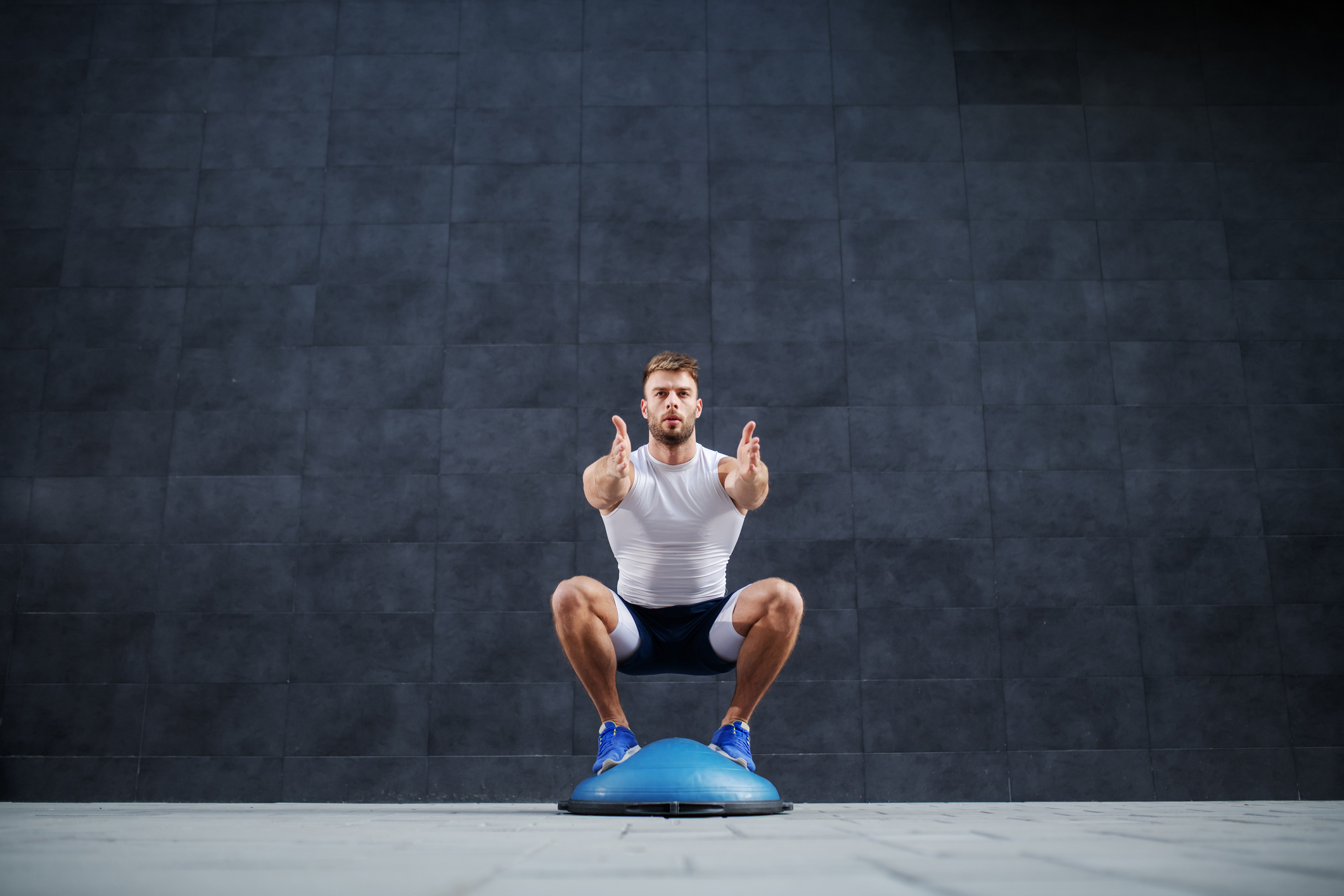Sue Wilkie explores functional balance training using the BOSU.
Balance represents an ability to stabilise and maintain a desired body position. Functional balance training, however, challenges the body to maintain proper postural control throughout a series of demands placed upon it, typically while standing still or through advanced transitional movements.
Balance training provides a tremendous benefit for people of all ages and abilities, from fall prevention in the elderly to increased ability to generate power in a vertical jump for the athlete. It can be easily incorporated into an exercise routine.
Using stability or balance training is the perfect way to stimulate and train the complex interaction of the body. Think about common activities and it quickly becomes apparent that most movements depend on co-ordination, balance and changing force output of the body.
Understanding and defining functional training
Several components represent key building blocks that contribute to safe, effective and functional movement, as well as skilled performance:
- Kinesthetics sense: Provides awareness of how the body is positioned at any moment. Kinesthetics or proprioceptive sense allows the body to perceive or feel movement.
- Proprioception overlaps with kinesthetics awareness and provides a sense of body symmetry, or necessary balance and positioning between body parts, and specifically refers to a sense of joint position.
- Graduation of force: The ability to control muscular force production and maintain an equalised, though dynamic, position regardless of the physical task critical to any type of human movement.
These three components of body equilibrium are important to consider and train when used in reference to daily movement requirements and demands of sports performance. Being able to change your centre of gravity to compensate for a required movement is the key to moving skilfully throughout life.
What is the BOSU balance trainer?
Pronounced “Bo Sue”, the BOSU was invented by David Weck in 2000. The acronym stands for Both Sides Utilised and its essence is about expanding movement capabilities while reshaping the body and strengthening the mind. BOSU training comprises thoughtful movement that requires the participant to be physically involved as well as ‘here and present’, with the mind fully engaged. BOSU training can be physically demanding but, when taught properly, it is appropriate for a variety of fitness levels and physical capabilities.
How to incorporate BOSU training into your programmes
There are four balance challenge variables to apply when using the BOSU Balance Trainer:
- Contact points
- Visual effect
- Movement
- External stimulus
Mastering these four variables and practising how they can be adapted to each exercise in your library will unlock limitless possibilities and optimise your BOSU balance training.
Contact points
A contact point refers to anything that is supporting the body while at work and, in this case, it’s the balance trainer. It can either be a body part that remains in contact with the BOSU or equipment that adds support, such as a wall, the floor, a trainer or another piece of kit. As a rule, utilising more contact points results in an easier exercise.
For example, a four-point prone can be modified from hands on BOSU to hands off to challenge your balance. By removing one part of your body, you can increase the balance challenge variable.
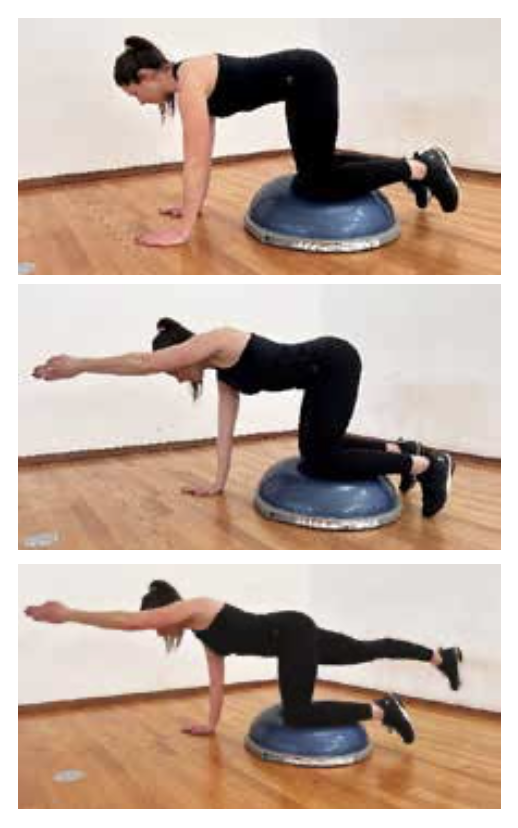
BOSU CONTACT POINTS
Visual effect
Manipulating the type of feedback received from the eyes will have one of the biggest effects on performance. When the eyes are closed during any activity, whether that be on a stable or unstable surface, the challenge will immediately become harder. How well someone can see (visibility) and where their eyes are focused (focal point) are both elements of visual effect.
Visibility
Closing one or both eyes during an activity will stimulate the proprioceptive or sensory receptors, as visual feedback has been eliminated. Combining this with a piece of kit such as the BOSU can help to prepare the body to react to balance challenges in day-to-day life.
Focal point
Take, for example, a gymnast who uses the principles of ‘spotting’ to assist them in a safe execution while performing their skills. The flipside of this is something we have all done as trainers/instructors when we have worked with a client whose balance is challenged in, say, holding a quad stretch. We might ask them to focus on one point on the floor or wall.
If you are looking to find one simple challenge this week, try making an exercise easier or harder by manipulating focal point or visibility.
For example: Standing or kneeling on a BOSU, place both hands in front of the body, focusing on the middle finger. While maintaining balance, track one hand around the side of the body. (Feel how the bodyweight transitions and fights to maintain balance.) To add more of a challenge, track the hand in a circle above the body.
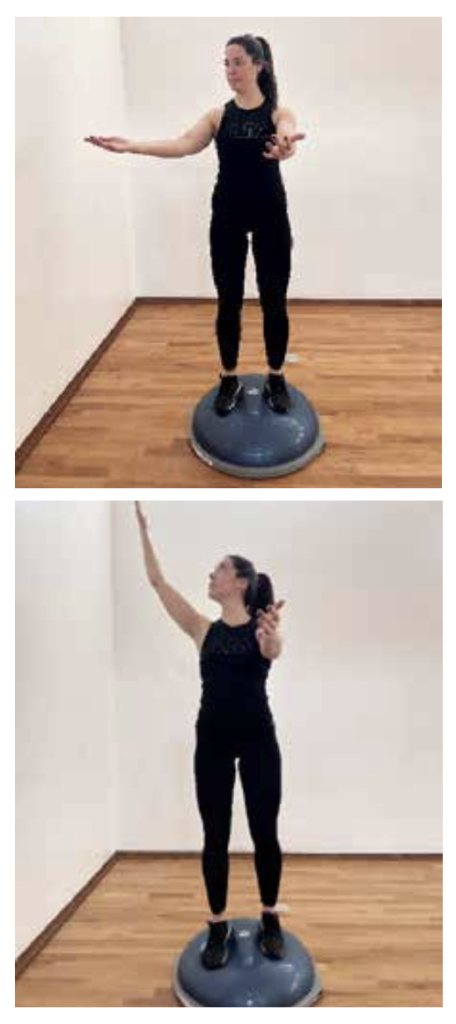
BOSU FOCAL POINT
Movement
Using movement as a balance challenge variable is simple and opens up unlimited possible exercise variations. As a rule, the more movement (range of motion) that is used on the balance trainer, the harder the exercise will be to perform.
For example: Lower-body exercises (e.g., squats and lunges) can be varied by using multi-directional and multi-regional exercises. A side-to-side squat can be made more challenging by increasing the range of movement from a shallow squat to a jump across the top.
The speed of a movement can also be varied to increase or decrease the challenge.
A side-to-side squat can be adapted by reducing or increasing the range of motion, by increasing the speed or propulsion, or by adding an external stimulus.
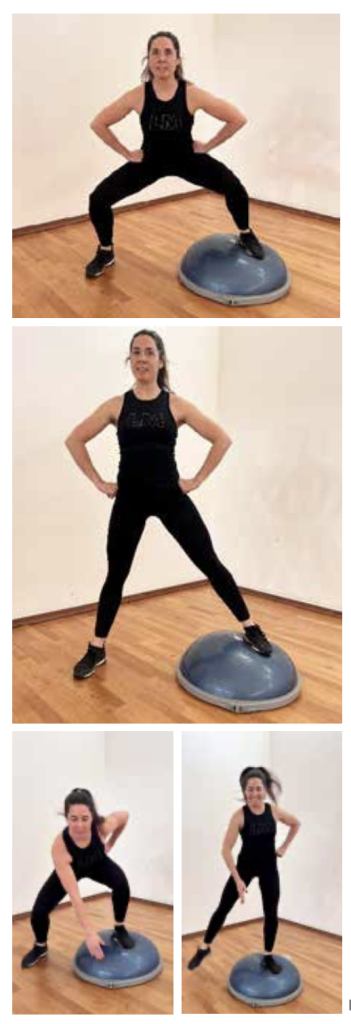
BOSU MOVEMENT
External stimulus
External stimulus refers to any outside force used during an exercise or drill. This can be as simple as adding a med ball to add resistance or a trainer gently applying an alternating force to a client to challenge their reaction to their balance. There are endless options for adding or subtracting outside force, and the options can not only make the exercises on the balance trainer more or less challenging but add an element of fun too.
For example: Catching a soft fitness ball while executing a V-sit exercise for the core or partnering up and playing catch.
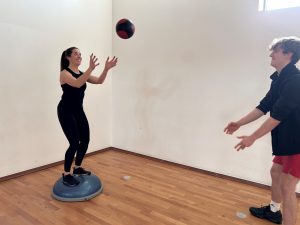
BOSU EXTERNAL STIMULUS
Combining the balance challenge variables
It is important to develop your understanding of the balance challenge variables separately to start. However, each variable can be combined to create endless options for trainers and their clients while adding more fun to a workout session.
Make sure you take time to practice using them alone and then master the combinations. It’s only through practice and repetition that you can become a master of this balance trainer, allowing you to accommodate all your clients’ skill levels.

How to safely adapt exercise to the balance trainer
Now you have the four challenge variables, it’s time to put your knowledge to the test. However, there are some golden rules to adding these to a client’s programme:
- Progress any exercise slowly and sensibly.
-
- Be mindful that some exercises or progressions may not be right for an individual straight away. Start by taking an exercise and looking at modifications to reduce or increase the intensity/complexity of a movement before trying it with a client. Be patient and master the technique of each exercise or drill before moving to a more challenging alternative.
- This product may not be suitable for all your clients, so ensure you have a full understanding of what their ability and medical history is before trying this out. Take into consideration previous injuries and visual issues, which could provide implications for carrying out the exercises.
- Do NOT perform exercises standing on the platform side of the BOSU. By standing on the dome side, you can accomplish the same training goal in most instances, without increasing risk of a fall or injury. (However, the platform side can be used safely and effectively in any other exercises that don’t require standing.)
- Space needed: You need to ensure there is enough room for a participant to lie prone, supine or in an inside-lying position, which would equate to around 12-16 square feet of space (similar to that of a step platform).
- Inflation: It is recommended that the dome be inflated to a firm density and a height of about 8-10 inches from the floor.
Author Bio:

Sue Wilkie
Sue Wilkie is Head of Workforce (Governance and Partnerships) at EMD UK. Leading the workforce charge for Group Exercise at EMD UK. With 30+ years of experience from leading classes and training instructors, to representing major brands across Europe and even advising the government on Group Exercise during lockdown, she brings unparalleled expertise to her role. A passionate champion of instructors, ensuring they have the support and resources to thrive and ensuring the voice of group ex is heard loud and clear.


